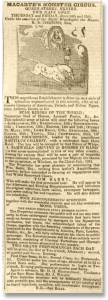Equestrian
 Born to William and Mary Ann Samwell in Lynn, England, John later added an extra ‘s’ to his surname in his adult career. As a child, he was an infant equestrian in his father’s travelling circus following the southern and eastern annual fair routes. He was barely in his teens when his father died in 1834 and his mother took over Samwell’s Circus and included northern counties in their travel schedule.
Born to William and Mary Ann Samwell in Lynn, England, John later added an extra ‘s’ to his surname in his adult career. As a child, he was an infant equestrian in his father’s travelling circus following the southern and eastern annual fair routes. He was barely in his teens when his father died in 1834 and his mother took over Samwell’s Circus and included northern counties in their travel schedule.
In August 1835 Samwell’s Circus performed before King William IV and Queen Adelaide in Egham, Surrey. A year later, the circus was patronised by Princess Victoria and her mother, the Duchess of Kent, at Ramsgate in Kent.
On the death of his mother in 1840 older brother Stephen took over management of the circus for a short while before handing over to his brother-in-law Henry Cornwall. In 1843 John left Cornwall’s Circus and worked in different circuses travelling throughout England sometimes making appearances alongside Stephen and his younger brother William.
John concentrated on character equestrianism playing roles such as The Farmer’s Boy, the Ariel Sprite, the Flying Olympian Horseman, the Tartar Horseman, the Gladiator Horseman, the Spanish Don, the Eagle Horseman of Corfu, and Napoleon.
In 1849 John joined John Ginnett’s circus and met equestrienne Charlotte Partridge and they married in 1849. They had eight children but only two survived to adulthood: Amy became a noted slack-wire artiste; and Roland became a ringmaster and creative set designer.
Over coming years John had long engagements with Ginnett’s, Macarte’s, and Quaglieni’s Circuses as well as short stints with smaller circuses travelling throughout Britain. He was sometimes joined by Amy, William, younger brother Thomas, and his brother-in-law Henry Walker. A spectacular feat of his was to drive twenty-four horses in a grand procession heralding the arrival of the circus in a town. Perfecting his equestrian characters, he was frequently billed as The Great Star Rider of England. He also specialised in the Risley Act which required deft juggling whilst standing on a galloping horse. He was still adding different characters to his equestrian repertoire, such as the Shakespearian characters Shylock and Richard III.
In 1867 while performing in Scotland John had an accident which crippled his right arm and severely curtailed his career and he was never billed again. He was still able to work in circuses but in minor roles.
After John’s accident Charlotte took over a boarding house in Lambeth which offered lodgings to passing circus and theatrical performers. But John’s health deteriorated and he died in 1883 of cirrhosis of the liver. His passing was noted in many local newspapers and even in the USA.
(Advertisement from The Western Times 9 July 1853. Image © The British Library Board. All rights reserved. Image reproduced with kind permission of The British Newspaper Archive www.britishnewspaperarchive.co.uk.)
Contact Caroline Cavanagh at samwellcircus@tpg.com.au to purchase a copy of Once a Famous Circus which provides much more detail on the Saunders and Samwell travelling circus families.
Text © Caroline Cavanagh 2017.